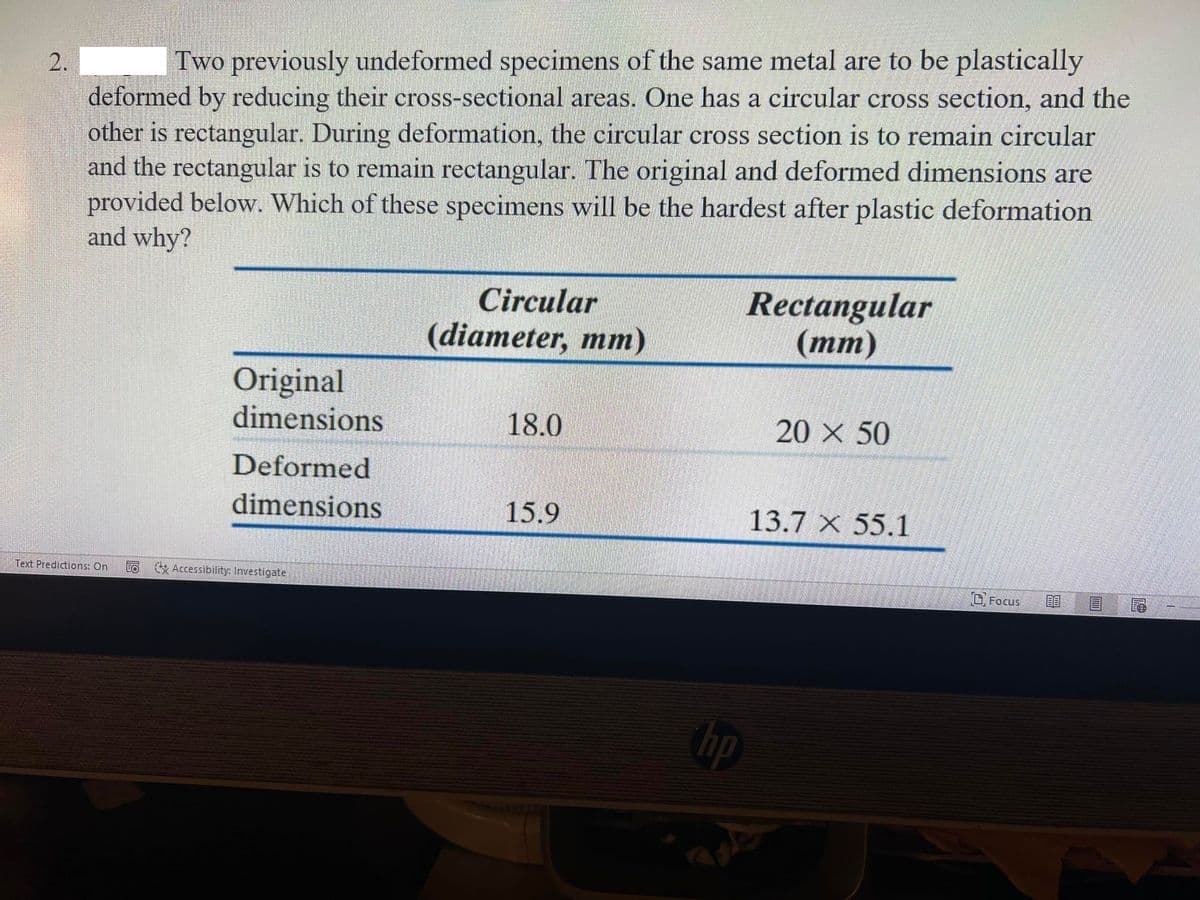Two previously undeformed specimens of the same metal are to be plastically deformed by reducing their cross-sectional areas. One has a circular cross section, and the other is rectangular. During deformation, the circular cross section is to remain circular and the rectangular is to remain rectangular. The original and deformed dimensions are provided below. Which of these specimens will be the hardest after plastic deformation and why? Rectangular (тт) Circular (diameter, mm) Original dimensions 18.0 20 X 50 Deformed dimensions 15.9 13.7 X 55.1 Text Predictions: On Accessibility: Investigate DFocus bp 2.
Two previously undeformed specimens of the same metal are to be plastically deformed by reducing their cross-sectional areas. One has a circular cross section, and the other is rectangular. During deformation, the circular cross section is to remain circular and the rectangular is to remain rectangular. The original and deformed dimensions are provided below. Which of these specimens will be the hardest after plastic deformation and why? Rectangular (тт) Circular (diameter, mm) Original dimensions 18.0 20 X 50 Deformed dimensions 15.9 13.7 X 55.1 Text Predictions: On Accessibility: Investigate DFocus bp 2.
Introduction to Chemical Engineering Thermodynamics
8th Edition
ISBN:9781259696527
Author:J.M. Smith Termodinamica en ingenieria quimica, Hendrick C Van Ness, Michael Abbott, Mark Swihart
Publisher:J.M. Smith Termodinamica en ingenieria quimica, Hendrick C Van Ness, Michael Abbott, Mark Swihart
Chapter1: Introduction
Section: Chapter Questions
Problem 1.1P
Related questions
Question

Transcribed Image Text:Two previously undeformed specimens of the same metal are to be plastically
deformed by reducing their cross-sectional areas. One has a circular cross section, and the
other is rectangular. During deformation, the circular cross section is to remain circular
and the rectangular is to remain rectangular. The original and deformed dimensions are
provided below. Which of these specimens will be the hardest after plastic deformation
and why?
Rectangular
(тт)
Circular
(diameter, mm)
Original
dimensions
18.0
20 X 50
Deformed
dimensions
15.9
13.7 X 55.1
Text Predictions: On
Accessibility: Investigate
DFocus
bp
2.
Expert Solution
This question has been solved!
Explore an expertly crafted, step-by-step solution for a thorough understanding of key concepts.
This is a popular solution!
Trending now
This is a popular solution!
Step by step
Solved in 2 steps with 2 images

Recommended textbooks for you

Introduction to Chemical Engineering Thermodynami…
Chemical Engineering
ISBN:
9781259696527
Author:
J.M. Smith Termodinamica en ingenieria quimica, Hendrick C Van Ness, Michael Abbott, Mark Swihart
Publisher:
McGraw-Hill Education

Elementary Principles of Chemical Processes, Bind…
Chemical Engineering
ISBN:
9781118431221
Author:
Richard M. Felder, Ronald W. Rousseau, Lisa G. Bullard
Publisher:
WILEY

Elements of Chemical Reaction Engineering (5th Ed…
Chemical Engineering
ISBN:
9780133887518
Author:
H. Scott Fogler
Publisher:
Prentice Hall

Introduction to Chemical Engineering Thermodynami…
Chemical Engineering
ISBN:
9781259696527
Author:
J.M. Smith Termodinamica en ingenieria quimica, Hendrick C Van Ness, Michael Abbott, Mark Swihart
Publisher:
McGraw-Hill Education

Elementary Principles of Chemical Processes, Bind…
Chemical Engineering
ISBN:
9781118431221
Author:
Richard M. Felder, Ronald W. Rousseau, Lisa G. Bullard
Publisher:
WILEY

Elements of Chemical Reaction Engineering (5th Ed…
Chemical Engineering
ISBN:
9780133887518
Author:
H. Scott Fogler
Publisher:
Prentice Hall


Industrial Plastics: Theory and Applications
Chemical Engineering
ISBN:
9781285061238
Author:
Lokensgard, Erik
Publisher:
Delmar Cengage Learning

Unit Operations of Chemical Engineering
Chemical Engineering
ISBN:
9780072848236
Author:
Warren McCabe, Julian C. Smith, Peter Harriott
Publisher:
McGraw-Hill Companies, The